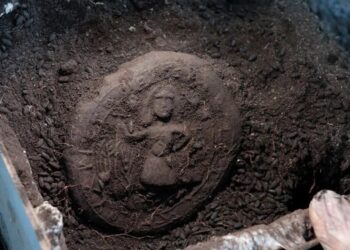INTERVIEW
Sofia Alazraki’s work involves a ritualization of inner strength and self-reflection. We sat down with the artist and designer to find out more.
What are some of your own rituals in the creative process that help you engage with these themes?
Rituals in my practice provide a sense of order, connection, and belonging, through which I navigate both my inner world and social interactions. I create personal ritualistic games—not tied to religion, but rather a self-invented mix of psychoanalysis, meditation, and raving—where I gather much of the material that later shapes my images, which can be absurd, sexy or deeply existential.
“Morning Rituals & Dissociation Tools” is the name of the solo show you are presenting for the first time in Tbilisi in collaboration with gallery Fotoatelier. In this exhibition there is a recurring theme of damage and reconstruction, where characters navigate connection and longing. How does this theme resonate with your personal creative journey?
My work is an infinite, ongoing conversation between destruction and reconstruction, isolation and belonging. The act of rebuilding something that cannot return to its original form, yet strives to become something new, mirrors my personal evolution. The images in the exhibition are a selection from an intimate exercise or game I’ve engaged in for over four years—an internal dialogue that transforms thoughts into images as a form of journaling.
Many of your scenes are imbued with absurdity, humor, and eroticism. How do you balance these elements, and what do they signify in the broader narrative of your work?
I love to work with objects that often go unnoticed—things that have been used, lost, dead, broken, or empty. I cast them as actors in a theater play or a constellation, creating scenes that tell the stories of contradictory characters longing for connection yet overwhelmed by damage. The combination of these objects represents the tender clumsiness of both myself and human existence. Sometimes, I envision my images as book covers in the self-help section; other times, as graphics for a hardcore porn film, perhaps using the same three objects. I like to situate myself within the border of spirituality and un-wokeness, a space that sometimes need some sense of humor and courage.
You’ve had an impressive career collaborating with exclusive fashion brands. How has your experience in the fashion industry influenced or challenged your independent creative practice? Do you find similarities between the two worlds?
I think both worlds complement and feed of each other. My experience in fashion has equipped me with the sharp technical tools, while my personal work creates a really safe space for exploration and play- I love to portray some cheap bazar treasure with the light and edit of a luxury piece of jewelry, At first glance, my photos might give the impression that someone is trying to sell you something, but upon closer inspection, they’re made of discarded or broken materials no one would typically want. I need a bit of both worlds to fully function, I love the conversation with other creatives in the fashion scene, but I also crave the madness of solitude and introspection that comes from working in the studio.
You are exhibiting in Georgia for the first time. What interests you most about showing your work here, and how do you view the Georgian art scene in relation to your own artistic approach?
The first time I visited Tbilisi, I fell in love. I had heard about its fierce manifestations, the mystery, music, street style and food. What surprised me was how much the atmosphere reminded me of my own city, Buenos Aires. Both places, though shaped by different circumstances, seem to create from adversity, with strong countercultural and deeply underground scenes as part of their core identity. The Georgian art scene is super inspiring to me—playful, dark, genuine, and elegant, but most of all, they are the coolest hosts.
WHERE: Gallery Fotoatelier, 14 P. Ingorokva St.
Opening time: 26 September, 19:00














